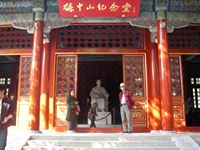In the ancient Land of Israel, what was the supreme council and tribunal?
The Sanhedrin were assemblies of either twenty-three or seventy-one rabbis appointed to sit as a tribunal in every city in the ancient Land of Israel.
There were two classes of rabbinical courts called Sanhedrin, the Great Sanhedrin and the Lesser Sanhedrin. A lesser Sanhedrin of 23 judges was appointed to each city, but there was to be only one Great Sanhedrin of 71 judges, which among other roles acted as the Supreme Court, taking appeals from cases decided by lesser courts. In general usage, "The Sanhedrin" without qualifier normally refers to the Great Sanhedrin, which was composed of the Nasi, who functioned as head or representing president, and was a member of the court; the Av Beit Din or chief of the court, who was second to the Nasi; and sixty-nine general members (Mufla).
In the Second Temple period, the Great Sanhedrin met in the Temple in Jerusalem, in a building called the Hall of Hewn Stones. The Great Sanhedrin convened every day except festivals and the sabbath day (Shabbat).
More Info:
en.wikipedia.org





